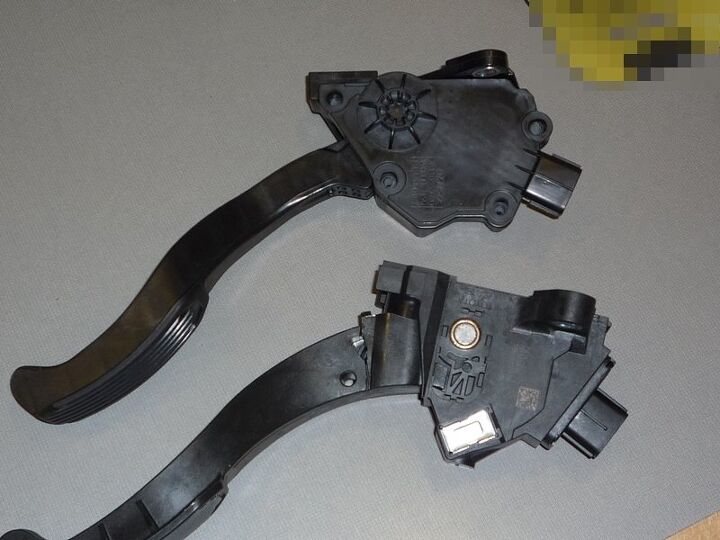The Complete Guide To Toyota Gas Pedals: Teardown, Pictures, Toyota's Fix, Analysis, And Commentary

Here’s TTAC’s and the web’s only complete guide to Toyota’s gas pedals (so far), with tear downs, pictures, analysis, explanation, the shim fix, and commentary, all consolidated into one portal:
Part 1: Exclusive: TTAC Takes Apart Both Toyota Gas Pedals: Tear down of both the recalled CTS pedal assembly and the non-recalled Denso pedal assembly. Note: Assumptions and conclusions in this initial tear down lack the more complete understanding of the importance of the friction arm aspect of the CTS unit.
Part 2: Toyota Gas Pedal Fix Explained – With Exclusive Photos: Describes Toyota’s proposed fix for the recalled CTS gas pedal assembly, with detailed photos and graphics. Explains the significance of the friction arm assembly and its limitations.
Part 3: Toyota Gas Pedal Fix Simulated – Friction Reduced, By Too Much?: TTAC simulates the fix prescribed by Toyota for the recalled CTS pedal assembly, and notes how the fix changes the degree of friction, and the possible unintended result. With detailed pictures
Part 4: Why Toyota Must Replace Flawed CTS Gas Pedal With Superior Denso Pedal: Detailed analysis with pictures of the two pedal assemblies, an explanation as to why the Denso design is superior, and a call for having all CTS pedals replaced with the Denso pedal.
Part 5: TTAC Does The Toyota Pedal Shim Fix: Stop Gap Solution At Best: Toyota’s solution is carried out here with detailed pictures, the whole Toyota document detailing the fix, and our commentary.
Part 6: Toyota Floor Mat/Gas pedal Recall Includes Computer Reflash And Trimming Of Gas Pedals: Info on the details of the floor mat/gas pedal interference recall.
Part 7: Toyota Recall Creates Unintended Accelerator Consequences: As predicted in Part 4 (above), the CTS shim fix reduces the carefully designed amount of friction required for comfortable and smooth pedal action to the point where pedal action may now be jerky and potentially unsafe.
(Thanks to you-know-who-you-are for access to these parts and info)

More by Paul Niedermeyer
Latest Car Reviews
Read moreLatest Product Reviews
Read moreRecent Comments
- MaintenanceCosts "GLX" with the 2.slow? I'm confused. I thought that during the Mk3 and Mk4 era "GLX" meant the car had a VR6.
- Dr.Nick What about Infiniti? Some of those cars might be interesting, whereas not much at Nissan interest me other than the Z which is probably big bucks.
- Dave Holzman My '08 Civic (stick, 159k on the clock) is my favorite car that I've ever owned. If I had to choose between the current Civic and Corolla, I'd test drive 'em (with stick), and see how they felt. But I'd be approaching this choice partial to the Civic. I would not want any sort of automatic transmission, or the turbo engine.
- Merc190 I would say Civic Si all the way if it still revved to 8300 rpm with no turbo. But nowadays I would pick the Corolla because I think they have a more clear idea on their respective models identity and mission. I also believe Toyota has a higher standard for quality.
- Dave Holzman I think we're mixing up a few things here. I won't swear to it, but I'd be damned surprised if they were putting fire retardant in the seats of any cars from the '50s, or even the '60s. I can't quite conjure up the new car smell of the '57 Chevy my parents bought on October 17th of that year... but I could do so--vividly--until the last five years or so. I loved that scent, and when I smelled it, I could see the snow on Hollis Street in Cambridge Mass, as one or the other parent got ready to drive me to nursery school, and I could remember staring up at the sky on Christmas Eve, 1957, wondering if I might see Santa Claus flying overhead in his sleigh. No, I don't think the fire retardant on the foam in the seats of 21st (and maybe late 20th) century cars has anything to do with new car smell. (That doesn't mean new car small lacked toxicity--it probably had some.)


































Comments
Join the conversation
I am so sick of people like the person who commented above. Toyota has an issue with their vehicles that is a safety related issue and it needs to be fixed. Did the guy who commented above actually read the analysis done in this Blog? If so I guess he did not understand it too well because he is still living under the floor mat with Toyota. I work for one of the automakers and know that we would never try and ignore this issue at ANY cost!!!!
Paul,,,after looking over most of the comments on TTAC it seems obvious to me that few of you understand what the shim does. Part of this is due to incorrect & misleading drawings made by Toyota ( and the A.P.). Installing the shim ELIMINATES the contact between the frictional elements which therefore gets rid of any "sticking" problem and it also ELIMINATES their frictional effects! That is why there are reports of "soft" pedal operation. I will try to explain the pedal operation... the pedal arm pushes against the spring which pushes against the rocker arm, the spring force is reacted at the other end by contact of the friction surfaces which results in drag when the pedal arm moves. When a thick shim is inserted the spring will bottom-out the rocker arm ON THE SHIM and the friction pads will not be in contact! A thin shim would of course have no effect; it's an on or off situation...